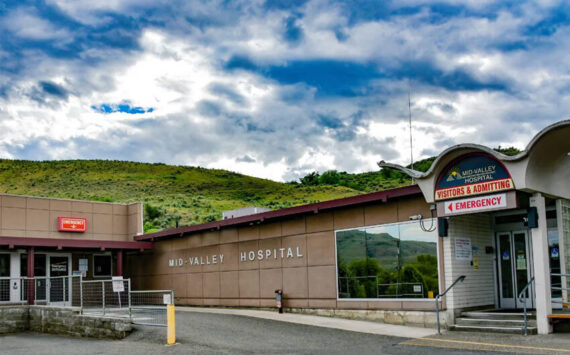Mayor gets DOT’s attention regarding state of US-97
TONASKET – Three motions, two votes, one hard-won agreement by the Tonasket City Council means that the Tonasket Police Department will be in the market for a new police vehicle.
Not “new” (as in a patched-together remnant from another department), but brand spanking new, with the help of a Rural Development loan/grant that will allow the city to spend up to $30,230, with just over half of that in grant money.
The city would take on a loan of $12,700 and come up with a $2,330 “applicant contribution.”
Where to come up with the money to take care of a monthly car payment of $237 to pay off the loan was the topic of a spirited debate amongst the council members that stretched for over an hour.
In the end, thanks to a motion by council member Scott Olson, the council unanimously approved the acceptance of the loan, with 50 percent of the monthly payment to come from the regular police budget, with the other half from the capital expense fund.
The grant/loan could only be used for a new vehicle and could not be used for a vehicle that was significantly less expensive.
“In the past we’ve always gotten used cars,” said Sgt. Darren Curtis, on hand in place of Chief Rob Burks. “Cars we ended up with in the past, most are 60, 70, 80,000-mile cars. We get about 20,000 miles before they start nickel and diming us to death.
“I put 10-13,000 miles on my car each year, 90 percent here in town. A lot of it is idle time that is not included in the milage. My car is at 104,000 miles, but if equated to actual hours it’s closer to 200,000 miles.”
Curtis pointed out that a new vehicle would come fully equipped for police use, with only a radio needing to be installed. Repair bills should be significantly reduced, he said, particularly in the first few years while it is under warranty. And fuel efficiency in newer vehicles would also save the city significant money.
“The grant is what it is,” said Mayor Patrick Plumb. “We don’t get it unless we get a new car. Basically we were able to get it because our fleet sucks (due to age) and we need to do something about it before we really eat it big.”
The council wasn’t unconvinced as to the need for the new car, considering that even with the recent purchase of a used vehicle over the winter, the department’s four officers are one breakdown away from having to share vehicles. But management of the department’s finances became the central topic of debate.
“”I’m comfortable with this to a point,” said council member Jill Vugteveen. “Getting under a reasonable amount of expenditures on (on call and overtime hours)… that’s a big issue there. It just seems its’ been so difficult to work with Rob and get that to managable level.
“He’s already struggling to find a balance between the demands of the police station, which I get, and the hours of the officers. To say now, he has to work on those hours better, plus we’re throwing a $237 a month car payment for him to manage in the same budget … I don’t have faith we’ll be successful. It just compounds the issue.”
The original motion by Jean Ramsey to accept the loan/grant as is failed 3-2. Olson’s original motion, that would have placed spending restrictions on the department, failed to draw a second.
“This is a good deal,” Olson said, prior to his motion that actually passed. “This should save the money. When I made my original motion, I just want to make sure Rob looks at these numbers. It doesn’t seem like we’re asking a lot of money each year.”
“If we’re going to sacrifice and take risk on Rob, if this is his priority, I am asking he make some sacrifice too,” Vugteveen said.
Heavy haul talk
A frequent topic of discussion of late, the Heavy Haul corridor debate is still simmering throughout the county. Plumb said he was finally able to get the Washington Department of Transportation’s attention by sending an email to every contact on the DOT’s web site after learning that a project bid had been awarded to chip seal the travel lanes on Whitcomb Avenue through the downtown Tonasket core.
The city has been trying for years (and had at one time been promised) a much more significant project that would more thoroughly repair the road, as well as take care of sidewalk and drainage issues.
“I expressed displeasure over the chip seal project,” Plumb said. “It was awarded without consideration to our functional issues with stormwater. Also the talk of heavy haul to Pateros… without significant investment, myself and the city council continue to oppose this effort. I urged DOT to discuss stopping all of these projects and coming up with a solution that would benefit all people in the state instead of just making our problems worse.
“I was just throwing out a last Hail Mary,” Plumb admitted.
Plumb received a response from Daniel Sarles of the DOT, expressing a willingness to meet with the city council to discuss the transportation issues. The email also pointed out:
* the chip seal project planned for this summer will cost about $100,000, while the needed improvements to the city core’s infrastructure would likely cost in excess of $5 million;
* the DOT shares the council’s concerns about the overall condition of the pavement structure in regards to creating a Heavy Haul corridor and estimated that not only downtown Tonasket, but the entire stretch of roadway to Pateros, would need roughly $55 million of work for that designation to be successful.
Sarles encouraged the city to pursue grants in an attempt to find the kind of funding necessary to get the work done, as the state transportation budget is not likely to allow that to happen in the forseeable future.
“DOT is not responsible for your water or sewer lines,” city planner Kurt Danison pointed out. “They are responsible only for the pavement. There are times they do curbs and gutters.
“The city’s approach needs to continue to be we can’t do it piecemeal. … We’ve been arguing it does us no good to address stormwater and curbing when we don’t know where the road is going to end up. It could all get torn out. We want it done all at once.
My suggestion is to approach DOT – they will be here in a couple weeks – and let them know that we want to work cooperatively with them. If there is a hard line with them where they will only be responsible between the curbs and we want to do the outside – we want to work with (in such a way as to coordinate projects).”
“I just want local people to understand that it isn’t a matter of the city not doing anything for 10 years,” Plumb said. “We’ve tried to address this issue but no one has taken it up with us. We have businesses closing in the afternoon when we have a flood, and we have basements under those that flood. It’s not staff, it’s not leadership; we are where we are. I want to move forward and fix it with whoever will help us.”




